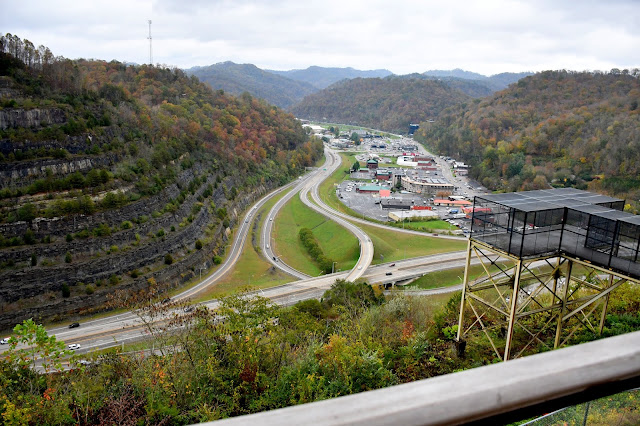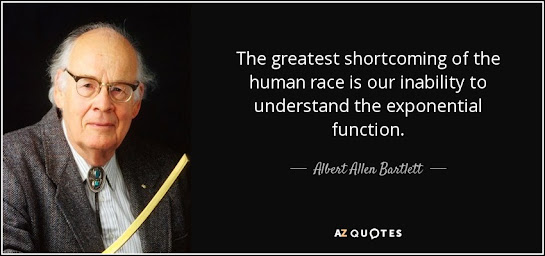Nuclear Power: Issues Regarding Ramping it up to Substitute Fossil Fuels
Picture of the Cook Nuclear Plant
At first glance, my thoughts regarding this topic are that I've actually probably covered most of it in my very first blog post here. However, I decided to try a new twist by asking members of a group I run what they'd like me to write about, and this was the first idea mentioned. There are particular angles of this topic which I have also covered here under the topic of denial and here under the topic of optimism bias. It is very important to cover the topic of psychology, because most people are affected in one way or another by predetermined beliefs and feelings based upon their worldview, upbringing, and schooling. No two people are going to agree 100% on everything; but utilizing logic, critical thinking, and consensus can minimize disagreements to a rather large extent.
Before I go any further, I need to point out that I am NOT pro-fossil fuels. For some reason, some people have gotten the misguided notion that I am some sort of fossil fuel shill, which couldn't be further from the truth. I have been accused of many other things which are also untrue but indicative of the sheer amount of denial and sometimes a rather large amount of ignorance regarding this topic. Perhaps the part that is most troublesome to so many people is that they mistakenly believe that we have the agency to extract ourselves from the boondoggle we find ourselves in with regard to ecological overshoot. Don't get me wrong, there ARE some things we can do to get going in the proper direction, but what MOST people want actually takes us in the WRONG direction. More energy, more cars of any stripe, and more technology (or efficiency) is what many people think will help. Unfortunately, this is precisely what brought us here, so it won't help us to get out of the messes we have created. One such idea, the Green New Deal, is nothing more than a recycled idea based upon the New Deal, which was brought about to ease the issues of the Great Depression.
The trouble with the difference between these "New Deals" is that one was accomplished during a time of massive surplus energy brought about by very high EROEI (Energy Return On Energy Invested) fossil fuels AND a constantly increasing supply. Now, on the other hand, not only do we have a decreasing EROEI, but we also now have a constantly DECREASING amount of supply as well. Surplus energy is the energy left over after the energy to extract coal, gas, and oil has been subtracted from what is extracted. This is the energy available to do the work of society such as pumping potable water to your house and pumping sewage from your house to the local sewage treatment plant. As time moves forward, the reason the EROEI is constantly going down is because all the best sources of fossil fuels which were easy to get are now gone and we have to keep drilling and/or mining further and further down to get to the deposits to extract them and bring them to the surface. Adding insult to injury, many of these locations are now also are very far from where the fossil fuels will actually be used, requiring increased transportation energy costs to the overall energy cost of providing these fuels.
Needless to say, the existing energetical conditions in the 1930's is MASSIVELY different to today's conditions. Another factor today is the fact that many more nations are now using fossil fuels than what were using them back in the 1930's, creating far more demand for what energy is available today. Recent figures from Shell indicate that they are planning on supplying about half of today's amount of gas and oil a decade from now. More jobs, more cars, and more technological devices means less energy to go around because it is being consumed in the arena of mining the minerals and resources necessary for all those cars, jobs, and devices, so less energy will be available for other areas such as the potable water and sewer systems we were talking about above, agriculture, and transporting everyday items from overseas to your doorstep. Do you like to eat food and drink water? What if you had to make a choice of food and water over electricity? It may seem ludicrous today, but this will become reality in the next two decades. Some people, like those in Texas, are discovering these realities right now.
A slightly different idea that has been championed by different climate scientists such as James Hansen is the use of nuclear energy. Now, nuclear energy isn't really any different than any other source of energy - it requires the fossil fuel platform for its very existence. In order for most nuclear power stations to exist, unbelievable amounts of steel and concrete were required including specialized types above what is normally required for common commercial structures due to the nature of the way the water is heated to turn the turbines. These plants therefore contain a massive carbon footprint even before they began operations. Secondly is the mining, transportation, and refining of uranium to fuel this heating of water. Thirdly is the continuous pumping of water required to keep the cooling pools at a reasonable temperature to prevent the used fuel rods from melting down. Last, but certainly not least, is the transporting of spent fuel to a nuclear storage facility. Because of the inherent danger of radioactive waste, no storage sites are yet available, which requires a fairly large amount of energy to (eventually) transport and store all this waste. How to do all this in an environment of consistently declining amounts of energy? Let's just put it this way - it's not a smart move to begin building more of these plants knowing what we know today, because there will be an absolute necessity to have the energy required to dispose of radioactive material to keep it away from society.
Of course, as everything, that was a very simple explanation based on traditional fission nuclear power stations operating on uranium. More info on fission options is available here. Considering this paragraph in that article, I think nuclear energy is more or less DOA, quote:
"Even though nuclear fission does not represent a renewable resource (at best we’re dealing with millennia, not eons), breeder programs can make it last long enough for me to throw it into the “abundant” box. Absent breeders, I must put conventional nuclear employing conventional mining into the “niche” box, since it can’t supply over a quarter of our demand for a meaningfully long period. Ocean harvesting allows conventional nuclear to jump straight over “potent” back to “abundant.” It’s worth emphasizing that we can’t simply ramp up the nuclear we know and—ahem—love, and expect to get much out of it."
Practically everyone has heard of fusion, and Tom Murphy presents the details here. Like all the other energy options, this one is the most technologically advanced, meaning the complexity is on a whole different scale. The sheer cost and scale of the ITER project is almost uncanny and the fact that it is "just" experimental is another reason to think that fusion is always going to be 20 years into the future. Now that we have passed the peak of fossil fuels, it is both safe and fair to predict that the idea of fusion is on a limited time basis. Some of the troubles are explained here, quote:
"The ITER experiment, if it adheres to its schedule and projected budget, will cost something like $20 billion to build and produce pops of unharnessed thermal power by 2026. I should note that most large experimental projects have slipping schedules, and it would be a fantastic irony if a fusion experiment violated this trend! In any case, we could imagine another several decades before commercial fusion tentatively steps onto the scene, putting us at mid-century. The projects will undoubtedly be very expensive, require intimate involvement of the highest level of expertise, and will likely not catch on in a big way until investors see a track record of profitability—if that ever comes to pass. So that’s fly number one: we’re looking at very long term.
Fly number two is that D-T fusion necessarily involves neutrons, which do not respond to magnetic or electrostatic confinement and therefore hurtle off to the walls of the containment vessel. In doing so, they knock into the atoms comprising the vessel, dislocating them within the lattice and causing structural damage. The integrity of the containment vessel will degrade like plastic in sunlight. The neutron flux from a D-T reactor is substantially higher than for a conventional fission reactor.
Fly number three is also related to neutrons: after doing their damage in the containment walls, the neutrons will marry a nice, plump nucleus and settle down. But the marriage is often radioactive, so that the container becomes radioactively “hot.” In fission, we get two radioactive daughters for each 200 MeV produced. For D-T fusion, if we are able to utilize most of the neutrons for conversion of lithium into tritium (and use enriched 6Li), we might be able to lose less than 0.2 neutrons per 20 MeV reaction (pure, uninformed guess on my part), which comes out to the same number of radioactive products per unit of energy. But at least materials choices for the container walls offers some control over the menagerie of radioactive products—unlike the randomness of fission. All told, the radioactive toll from a D-T fusion reactor may be comparable to that of a fission reactor, though with shorter half-life.
Then there is the extremely finicky nature of achieving fusion. Getting something to work in the lab is much different from having it operate reliably for years on end. Any significant departure from optimal conditions will see the fusion yield diminish. ITER aims for a thermal output ten times that of the input energy. In an eventual self-running mode, siphoning 10% of the output power in electrical form requires pulling out about 30% of the thermal power to run the heat-engine generator. This makes for a 3:1 net energy gain, which could quickly transition to a net energy drain if things are not maintained in tip-top condition through the years.
Another possible fly is that the superconducting magnets used to generate the extreme magnetic fields for confinement could lose cryogenic cooling, “go normal,” and explode. An explosion that damaged the tokamak could result in a radioactive release to the environment. Even though the probability is small, we routinely go to great expense to mitigate low-probability catastrophic events, and so a massive, expensive containment building would likely be required.
While we have focused on the technical aspects of nuclear energy, we should not forget the complexity involved. As Murphy pointed out, operating such facilities would require a stable society and conditions. As extreme weather events and extreme social events begin to shake the social fabric of the world's citizens (and we're just getting started), these facts knock nuclear energy out of the running in a realistic sense. I have little doubt that some will ignore these events anyway; although as time moves forward, the energetical conditions which originally allowed for such massive infrastructural construction will disappear. Extreme weather events also affect the viability of most all infrastructure, as has been recently been noted in Texas, including nuclear power facilities. Another factor related to extreme weather events and climate change is sea level rise. Many existing nuclear power facilities located near coastal waters or large rivers are in danger of being flooded or damaged by many different scenarios such as high tides, river flooding, hurricanes, cyclones, tornadoes, and extreme rain events. Finally, this article takes a look at these issues in a fairly comprehensive manner.
To add fuel to the fire, the issue of increasing complexity should definitely not be ignored. Many experts such as Ugo Bardi have warned us about the Seneca Cliff; the collapse which is currently unfolding as I type this. This article has been quite accurate regarding the beginning volleys. Nate Hagens describes the "Superorganism" and the implications here. Joseph Tainter described how increasing complexity often comes with diminishing returns. So, increasing complexity at a time of reduced flows of energy will not go according to plan. This combined with all the other logistical challenges make nuclear energy laughable as a means to heat water to turn turbines.
Update 6-1-2021: A recent article written by Ugo Bardi adds more information to this topic, which further points out just how ludicrous an idea more nuclear energy (or any other energy, for that matter) is to solve the predicaments we face. Perhaps the best way to express the sentiment with the constant stream of ideas regarding energy is this picture:
Along the same lines of thought is this article.
Update 7-7-21: although this article appears to be referring to older facilities.
Update 11-14-23: A new article from Art Berman.
Thanks to Wade Perkes for this idea!












Comments
Post a Comment